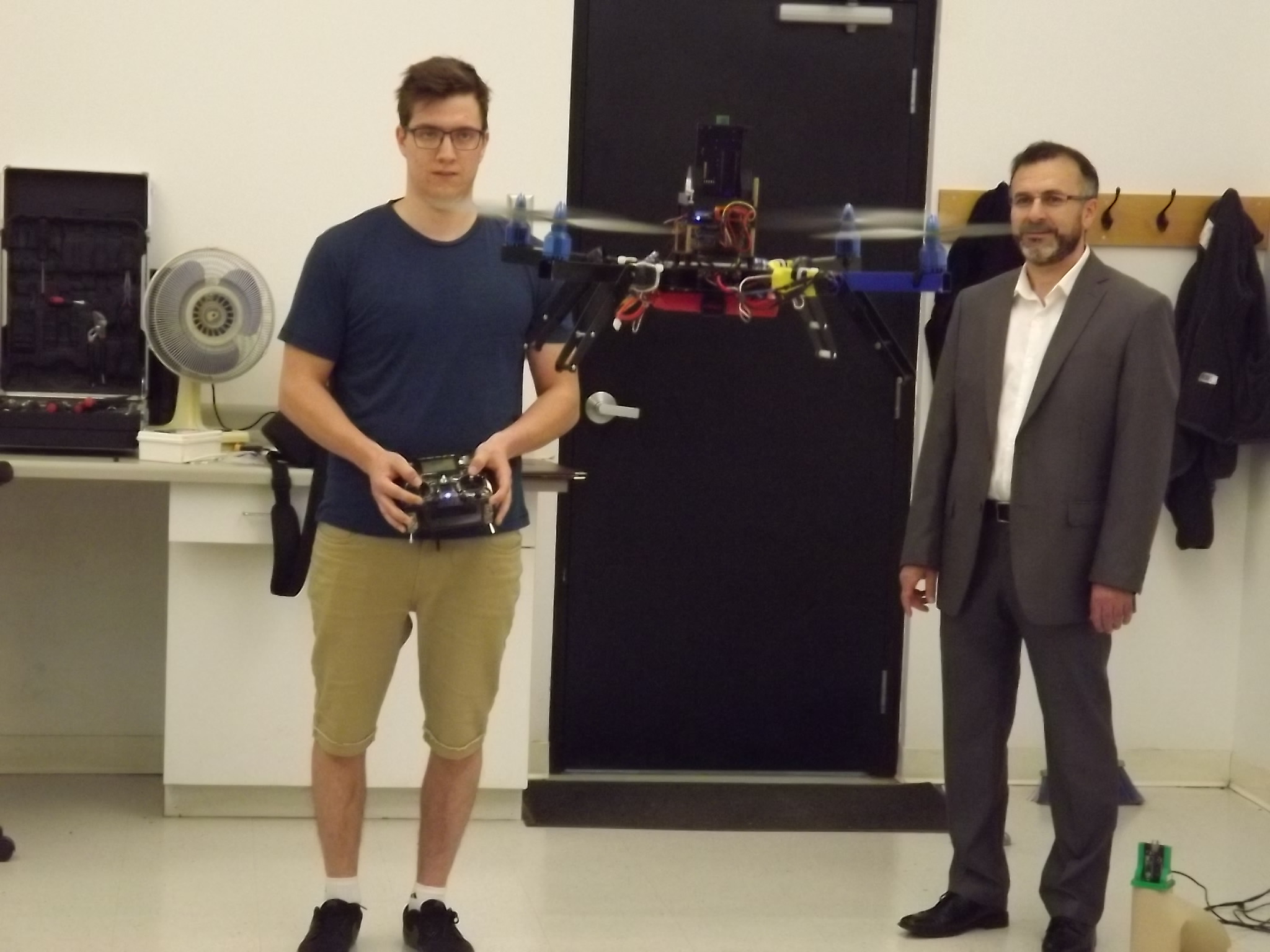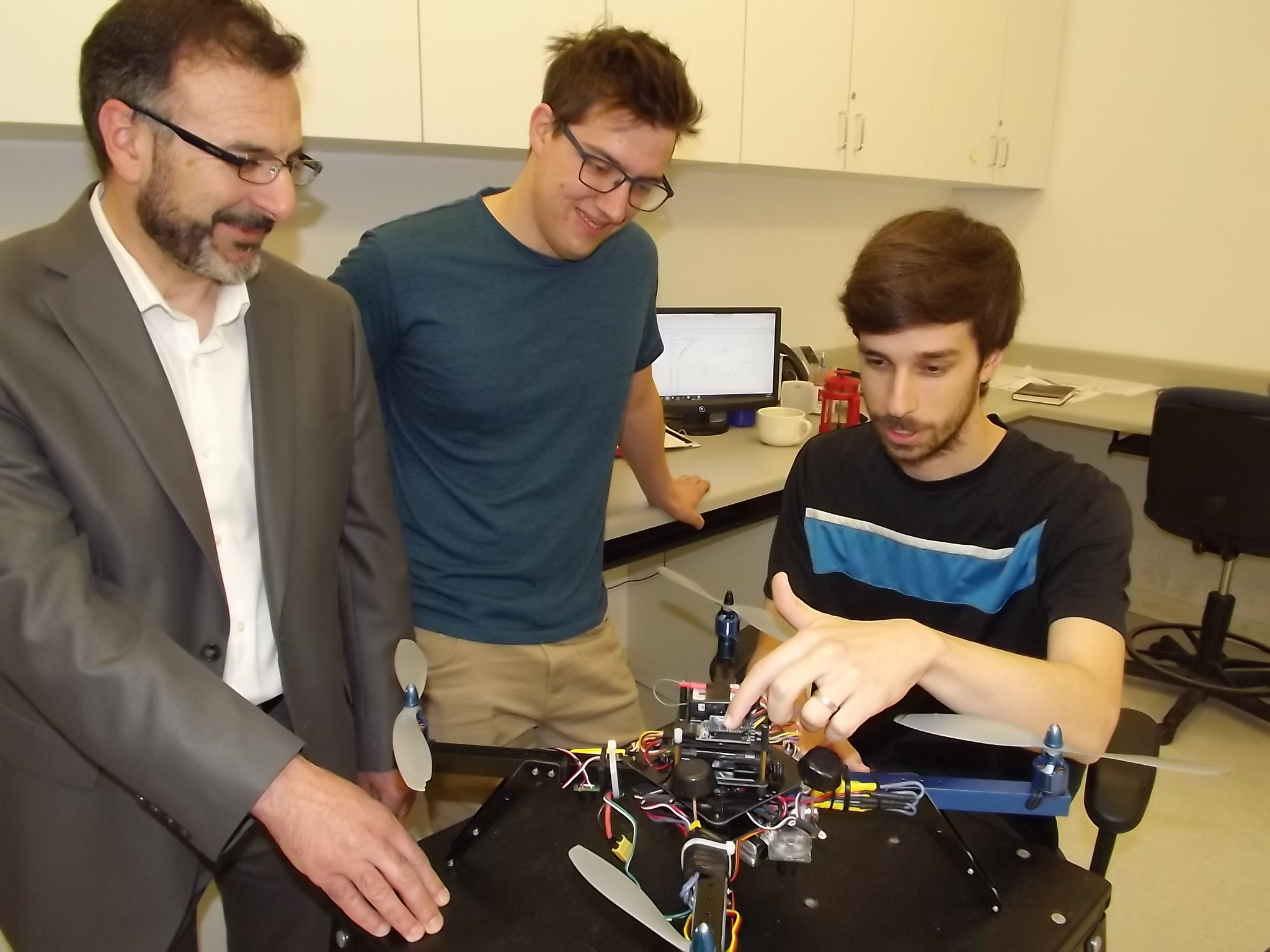Research in Action: Sky’s the limit for fully autonomous UAVs


Photo 1: Lakehead University professor Dr. Abdelhamid Tayebi joins graduate student Zeke Sedor as fellow student Geordi McGrath, right, goes over the cameras placed on an unmanned aerial vehicle.
Photo 2: Lakehead University professor Dr. Abdelhamid Tayebi, right, watches graduate student Zeke Sedor operate an unmanned aerial vehicle at the school’s Automatic Control Laboratory.
Published in the Chronicle Journal Thursday, July 26, 2018.
Imagine this: there’s a car crash on a highway and a First Aid kit arrives within minutes. Smoke is detected on a remote mountain and firefighting crews are dispatched to the hot spot. An alarm sounds at a nuclear power plant and damage assessment begins immediately.
In all of these scenarios, unmanned aerial vehicles, or drones, could play a pivotal role.
“You can equip drones with whatever you want, then you can send them to places where it’s dangerous to send humans or difficult to send robots,” suggests Dr. Abdelhamid Tayebi.
“But that’s a goal,” he cautions, “that’s a little bit far in the future.”
Tayebi, an Electrical Engineering professor at Lakehead University, has been working to make UAVs fully autonomous. That means, essentially, developing drones that can accomplish a task without human intervention.
“That’s the ultimate goal of all the people working in this area,” Tayebi explains. “It’s to one day send a UAV from some location, give it GPS co-ordinates and then the UAV goes to that location, choosing the best route to avoid obstacles and collision.”
There are a multitude of issues that have to be overcome before the skies are abuzz with drones, though. Tayebi acknowledges the huge task of building transmitters and receivers to track a drone’s exact position and then how to efficiently control a device the weight and size of a toy.
Progress is taking place at a small office on campus, the Automatic Control Laboratory, of which Tayebi is the director. On any given day, two graduate students are working on standard four-propellor drones, writing computer code, fixing minor mechanical issues and seeing where that takes them.
“It’s a real challenge,” says Geordi McGrath, a Master’s student in Electrical and Computer Engineering. “This work is a good culmination of what you learned in undergrad studies.
“Electrical engineering is very math heavy, so using equations from calculus and physics to control a physical system is quite satisfying.”
McGrath’s focus is on the two cameras mounted on the UAV, trying to figure out how the drone can know where it is based on what it sees. Getting the cameras properly calibrated has been both tedious and exhilarating.
“When I finally was able to complete the calibration successfully, there was such a relief,” he says. “But at the same time it was frustrating because it was a single mistake that caused months of issues.”
His colleague, Zeke Sedor, faces other challenges. On the white tile floor of the lab is the black outline of a large circle. His objective is to get the drone to fly in a particular path — in this case, follow the circle while airborne.
“Everything right now works, but nothing works together really well,” Sedor says.
“It sounds simple, but it’s really not,” he continues. “You first have to control the orientation to get it flat. Then, depending on the final position and the velocity information available from the sensors, you have to control the orientation to control the movement of the drone. That is a lot more complicated than it sounds. ‘Let’s trace a circle for the drone.’ It should be easy, but — ”
“Pretty much everything we’re doing,” McGrath adds, “sounds simple in concept, but the execution is the challenge,”
Tayebi can appreciate what his students are going through. He’s been at this research for 15 years and knows the hurdles that need to be overcome to make mini-aircraft available for a variety of important tasks.
“I tell my students it’s much easier to control a big spacecraft or satellite than to control a small drone,” he says, explaining that larger crafts have delicate and expensive sensors that you can’t afford for drones.
“These are challenging problems and we’re working on it. We have solved a few problems and there are other problems we’re trying to solve,” Tayebi acknowledges. “We’re still progressing.”

